Performance Evaluations of Warm-Mix Reaction-Rejuvenated SBS Modified Asphalt Mixtures Incorporated with Wax-Based Additive
Abstract
:1. Introduction
2. Materials and Experiments
2.1. Raw Materials
2.1.1. SBS-Modified Asphalt (SBSMA) Binder
2.1.2. Polyurethane (PU) Prepolymer
2.1.3. 1,4-Butanediol Diglycidyl Ether (BUDGE)
2.1.4. Warm-Mix Additive (Sasobit)
2.2. Research Flowchart
2.3. Preparation of Aged and Rejuvenated SBSMA Binders
2.4. Preparation of SBSMA Mixtures (SBSMAMs)
2.5. Preparation of Aged SBSMAMs
2.6. Preparation of Warm-Mix Reaction-Rejuvenated SBSMA Binders
2.7. Preparation of Warm-Mix Reaction-Rejuvenated SBSMAMs
3. Test Methodologies
3.1. Fourier-Transform Infrared Spectroscopy Test (FTIR)
3.2. Viscosity–Temperature Susceptibility Test (VTS)
3.3. Moisture-Induced Damage Tests
3.3.1. Marshall Tests
3.3.2. Freeze–Thaw Splitting Tests
3.4. Wheel Tracking Test (WTT)
3.5. Low-Temperature Bending Test
3.6. Semi-Circular Blending (SCB) Test
4. Results and Discussion
4.1. Effect of BUDGE/PU Reactive Rejuvenation on Molecular Structures of Aged SBSMA Binders
4.2. Viscosity–Temperature Correlation of Warm-Mix Reaction-Rejuvenated SBSMA Binders
4.3. Water Stability of Warm-Mix Reaction-Rejuvenated SBSMAMs
4.3.1. Residual Marshall Stability
4.3.2. Freezing–Thawing Splitting Strength Ratio (TSR)
4.4. High-Temperature Performance of Warm-Mix Reaction-Rejuvenated SBSMAMs
4.5. Low-Temperature Cracking Resistance of Warm-Mix Reaction-Rejuvenated SBSMAM
4.5.1. Flexural Strength
4.5.2. Flexural Strain at Break
4.5.3. Flexural Modulus
4.6. Fatigue Resistance of Warm-Mix Reaction-Rejuvenated SBSMAMs
5. Conclusions
- The viscosity–temperature correlation results indicated that Sasobit can significantly reduce the viscosity of RSBSMAs at warm-mix temperatures below 150 °C and slightly decrease the viscosity’s susceptibility to the temperature, especially at a dosage of 3%, through the reaction–rejuvenation method.
- The Marshall test results indicated that, regardless of immersion, warm-mix reaction–rejuvenation can help to improve the Marshall stability and moisture-induced damage resistance of ASBSMAMs, and the limited addition of Sasobit only has a slightly negative impact on the Marshall stability of RSBSMAMs.
- The freeze–thaw test results demonstrated that warm-mix reaction–rejuvenation will not significantly affect the splitting strength of RSBSMAMs, even when the Sasobit dosage reaches 3%, which shows benefits in improving the resistance of ASBSMAMs to freeze–thaw damage. However, with the greater incorporation of Sasobit, the resistance of warm-mix RSBSMAMs will slightly weaken.
- The rut deformation test results suggested that the addition of Sasobit will not cause warm-mix RSBSMAMs to develop rut deformation but shows benefits in helping to improve their resistance to permanent deformation, reaching DS values of 5733, 6276, and 6631 pass/mm with the incorporation of Sasobit at 1, 2, and 3%, respectively.
- The low-temperature performance results showed that the flexural damage resistance of ASBSMAMs at low temperatures can be enhanced after warm-mix reaction–rejuvenation, which will, however, gradually decrease to some extent with the increase in the dosage of Sasobit. In addition, the maximum flexural strain of RSBSMAMs can still reach 2515 με to satisfy the application requirement when the dosage of Sasobit is 3%.
- The fatigue test results implied that, under reaction–rejuvenation conditions, Sasobit will not reduce the fatigue resistance of RSBSMAMs; in fact, at limited higher dosages, they will work more effectively. Compared to ASBSMAMs, the susceptibility of Sasobit/RSBSMAMs to fatigue is lower, and, as the Sasobit dosage increases, the fatigue susceptibility of RSBSMAMs decreases slowly.
Author Contributions
Funding
Institutional Review Board Statement
Informed Consent Statement
Data Availability Statement
Conflicts of Interest
References
- Cao, Z.; Chen, M.; Liu, Z.; He, B.; Yu, J.; Xue, L. Effect of different rejuvenators on the rheological properties of aged SBS modified bitumen in long term aging. Constr. Build. Mater. 2019, 215, 709–717. [Google Scholar] [CrossRef]
- Chen, M.; Geng, J.; Xia, C.; He, L.; Liu, Z. A review of phase structure of SBS modified asphalt: Affecting factors, analytical methods, phase models and improvements. Constr. Build. Mater. 2021, 294, 123610. [Google Scholar] [CrossRef]
- Fen, Y.; Wei, Y.; Hang, L. A model for the quantitative relationship between temperature and microstructure of Styrene–Butadiene–Styrene modified asphalt. Constr. Build. Mater. 2015, 79, 397–401. [Google Scholar]
- Saleh, M.; Nguyen, N.H.T. Effect of rejuvenator and mixing methods on behaviour of warm mix asphalt containing high RAP content. Constr. Build. Mater. 2019, 197, 792–802. [Google Scholar]
- Zhou, J.; Li, J.; Liu, G.; Yang, T.; Zhao, Y. Recycling aged asphalt using hard asphalt binder for hot-mixing recycled asphalt mixture. Appl. Sci. 2021, 11, 5698. [Google Scholar] [CrossRef]
- Podolsky, J.H.; Saw, B.; Elkashef, M.; Williams, R.C.; Cochran, E.W. Rheology and mix performance of rejuvenated high RAP field produced hot mix asphalt with a soybean derived rejuvenator. Road Mater. Pavement Des. 2021, 22, 1894–1907. [Google Scholar] [CrossRef]
- Al-Saffar, Z.H.; Yaacob, H.; Satar, M.K.I.M.; Saleem, M.K.; Lai, J.C.; Putra Jaya, R. A review on rejuvenating materials used with reclaimed hot mix asphalt. Can. J. Civ. Eng. 2021, 48, 233–249. [Google Scholar] [CrossRef]
- Xu, X.; Sreeram, A.; Leng, Z.; Yu, J.Y.; Li, R.; Peng, C. Challenges and opportunities in the high-quality rejuvenation of unmodified and SBS modified asphalt mixtures: State of the art. J. Clean. Prod. 2022, 378, 134634. [Google Scholar] [CrossRef]
- Pasetto, M.; Baliello, A.; Giacomello, G.; Pasquini, E. Laboratory evaluation of the effectiveness of rejuvenation in multiple hot recycling of asphalt mixtures. J. Test. Eval. 2023, 51, 2075–2087. [Google Scholar] [CrossRef]
- Mahto, S.K.; Sinha, S. Application of marble dust and ground granulated blast-furnace slag in emulsified asphalt warm mixtures. J. Clean. Prod. 2022, 370, 133532. [Google Scholar] [CrossRef]
- Song, W.; Huang, B.; Shu, X. Influence of warm-mix asphalt technology and rejuvenator on performance of asphalt mixtures containing 50% reclaimed asphalt pavement. J. Clean. Prod. 2018, 192, 191–198. [Google Scholar] [CrossRef]
- Foroutan Mirhosseini, A.; Tahami, A.; Hoff, I.; Dessouky, S.; Kavussi, A.; Fuentes, L.; Walubita, L.F. Performance characterization of warm-mix asphalt containing high reclaimed-asphalt pavement with bio-oil rejuvenator. J. Mater. Civ. Eng. 2020, 32, 04020382. [Google Scholar] [CrossRef]
- Wang, Z.; Li, J.; Zhang, Z.; Jia, M.; Yang, J. Formulation of a new warm-mix recycling agent and its rejuvenating effect on aged asphalt. Constr. Build. Mater. 2020, 262, 120804. [Google Scholar] [CrossRef]
- Hasan, Z.; Hamid, B.; Amir, I.; Danial, N. Long term performance of warm mix asphalt versus hot mix asphalt. J. Cent. South Univ. 2013, 20, 256–266. [Google Scholar] [CrossRef]
- Cheraghian, G.; Falchetto, A.C.; You, Z.; Chen, S.; Kim, Y.S.; Westerhoff, J.; HoonMoon, K.; Wistuba, M.P. Warm mix asphalt technology: An up to date review. J. Clean. Prod. 2020, 268, 122128. [Google Scholar] [CrossRef]
- Chen, B.; Dong, F.; Yu, X.; Ren, S.; Zheng, C. Chemo-Rheological Characterization of Aging Behaviors of Warm-Mix High-Viscosity Modified Asphalt. J. Mater. Civ. Eng. 2022, 34, 04022342. [Google Scholar] [CrossRef]
- Almusawi, A.; Sengoz, B.; Topal, A. Investigation of mixing and compaction temperatures of modified hot asphalt and warm mix asphalt. Period. Polytech. Civ. Eng. 2021, 65, 72–83. [Google Scholar] [CrossRef]
- Munteanu, S.B.; Brebu, M.; Vasile, C. Thermal and thermo-oxidative behaviour of butadiene–styrene copolymers with different architectures. Polym. Degrad. Stab. 2005, 89, 501–512. [Google Scholar] [CrossRef]
- Saeid, S.; Afshar, Y.; Behnood, A. The effects of Gilsonite and Sasobit on the mechanical properties and durability of asphalt mixtures. Constr. Build. Mater. 2020, 238, 117676. [Google Scholar]
- Jamshidi, A.; Hamzah, M.O.; You, Z. Performance of warm mix asphalt containing Sasobit®: State-of-the-art. Constr. Build. Mater. 2013, 38, 530–553. [Google Scholar] [CrossRef]
- Wasiuddin, N.M.; Selvamohan, S.; Zaman, M.M.; Guegan, M.L.T.A. Comparative laboratory study of sasobit and aspha-min additives in warm-mix asphalt. Transp. Res. Rec. 2007, 1998, 82–88. [Google Scholar] [CrossRef]
- ASTM D5; Standard Test Method for Penetration of Bituminous Materials. ASTM International: West Conshohocken, PA, USA, 2006.
- ASTM D113; Standard Test Method for Ductility of Asphalt Materials. ASTM International: West Conshohocken, PA, USA, 2017.
- ASTM D36; Standard Test Method for Softening Point of Bitumen (Ring-and-Ball Apparatus). ASTM International: West Conshohocken, PA, USA, 2006.
- ASTM D4402; Standard Test Method for Viscosity Determination of Asphalt at Elevated Temperatures Using a Rotational Viscometer. ASTM International: West Conshohocken, PA, USA, 2006.
- Hu, J.; Jiang, X.; Shen, W.; Sreeram, A.; Ren, H.; Xu, X. Innovative Use of Polyurethane Precursor to Facilitate the Reaction-Rejuvenation of Aged SBS-Modified Asphalt. J. Mater. Civ. Eng. 2024, 36, 04024224. [Google Scholar] [CrossRef]
- Xu, X.; Yu, J.; Wang, R.; Hu, J.; Xue, L. Investigation of road performances of reaction-rejuvenated SBS modified bitumen mixture. Constr. Build. Mater. 2018, 183, 523–533. [Google Scholar] [CrossRef]
- Gong, J.; Han, X.; Su, W.; Su, W.; Xi, Z.; Cai, J.; Wang, Q.; Li, J.; Xie, H. Laboratory evaluation of warm-mix epoxy SBS modified asphalt binders containing Sasobit. J. Build. Eng. 2020, 32, 101550. [Google Scholar] [CrossRef]
- Xu, X.; Leng, Z.; Lan, J.; Wang, W.; Yu, J.; Bai, Y.; Sreeram, A.; Hu, J. Sustainable practice in pavement engineering through value-added collective recycling of waste plastic and waste tyre rubber. Engineering 2021, 7, 857–867. [Google Scholar] [CrossRef]
- ASTM D6927; Standard Test Method for Marshall Stability and Flow of Asphalt Mixtures. ASTM International: West Conshohocken, PA, USA, 2015.
- AASHTO T283; Standard Method of Test for Resistance of Compacted Asphalt Mixtures to Moistureinduced Damage. American Association of State Highway and Transportation Officials: Washington, DC, USA, 2014.
- ASTM D8292; Standard Test Method for Permanent Deformation Behavior and Rutting Resistance of Compacted Asphalt Mix in the Modified Loaded Wheel Tracker Test Utilizing Controlled Confining Pressure. ASTM International: West Conshohocken, PA, USA, 2020.
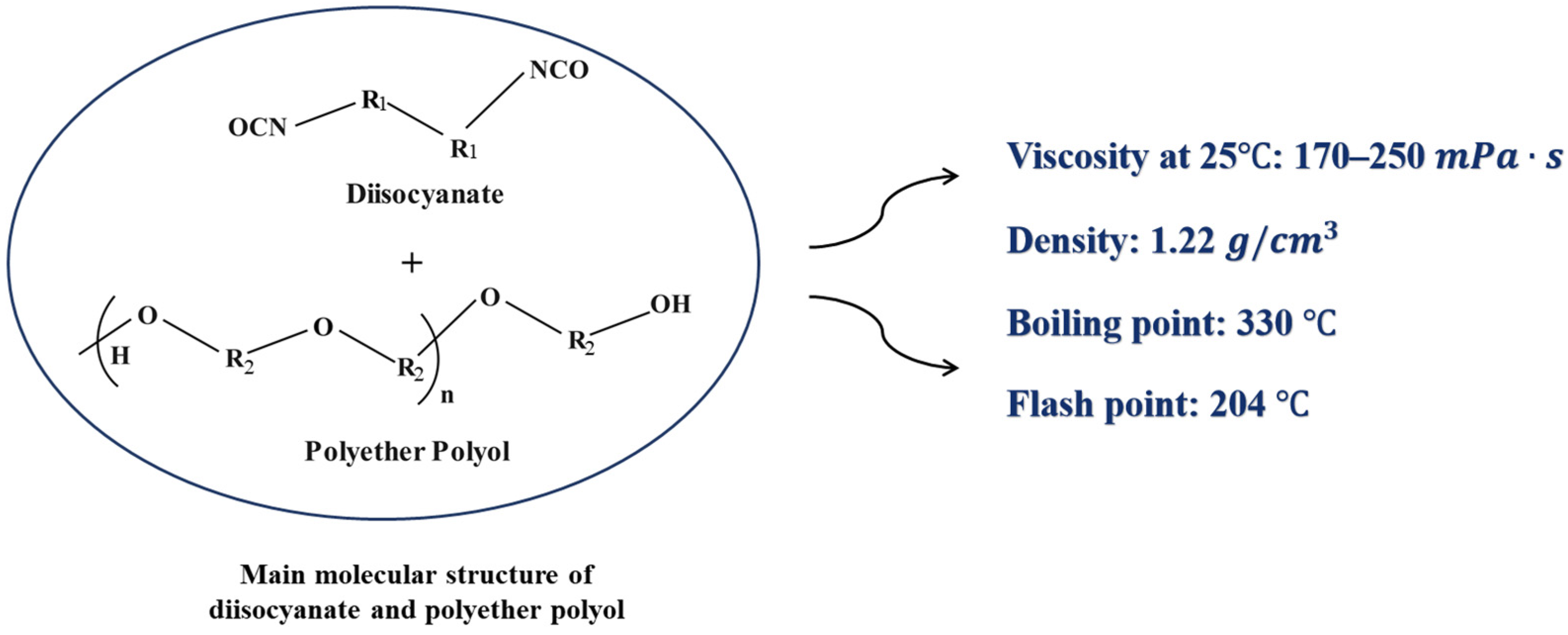
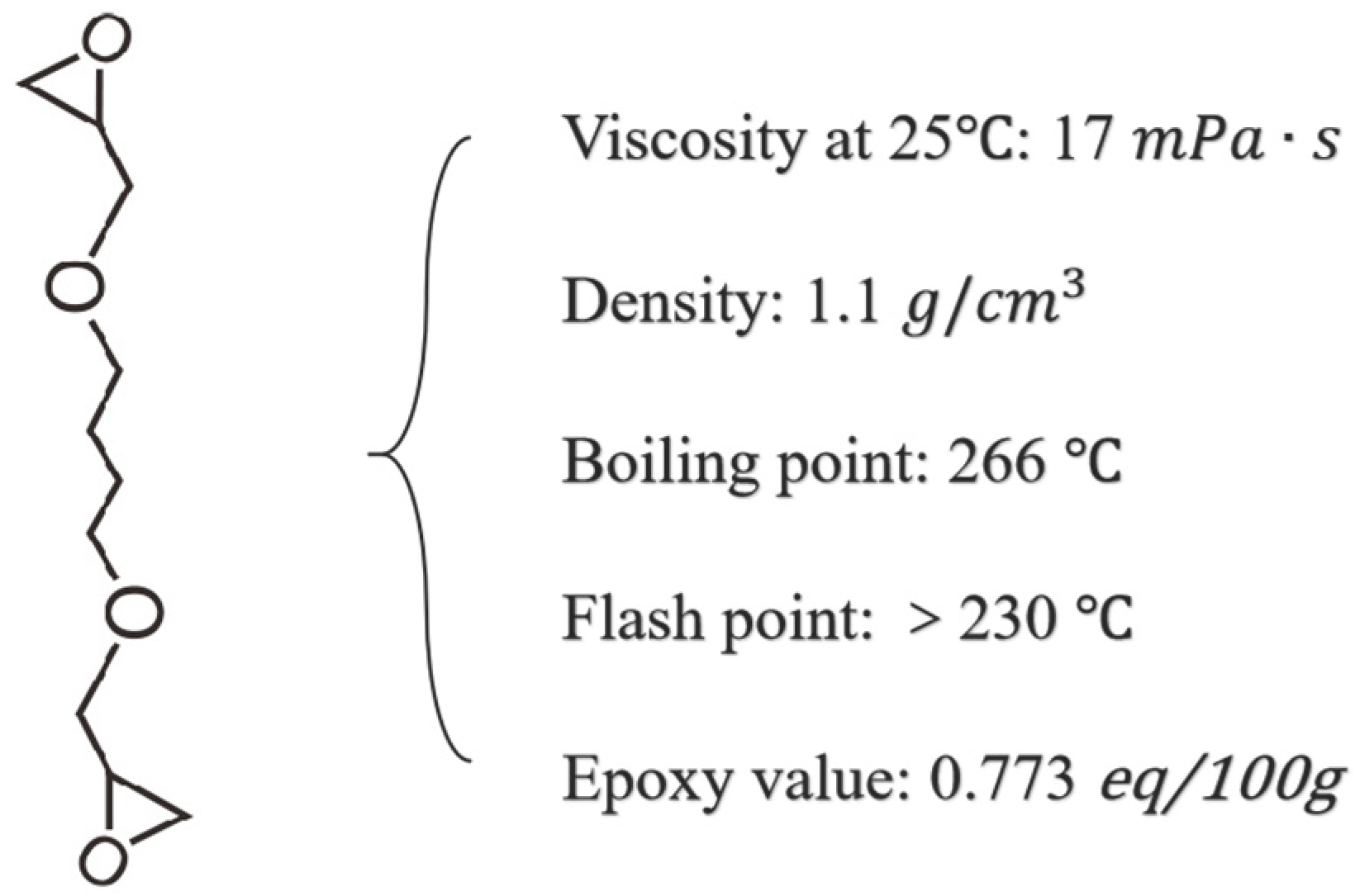
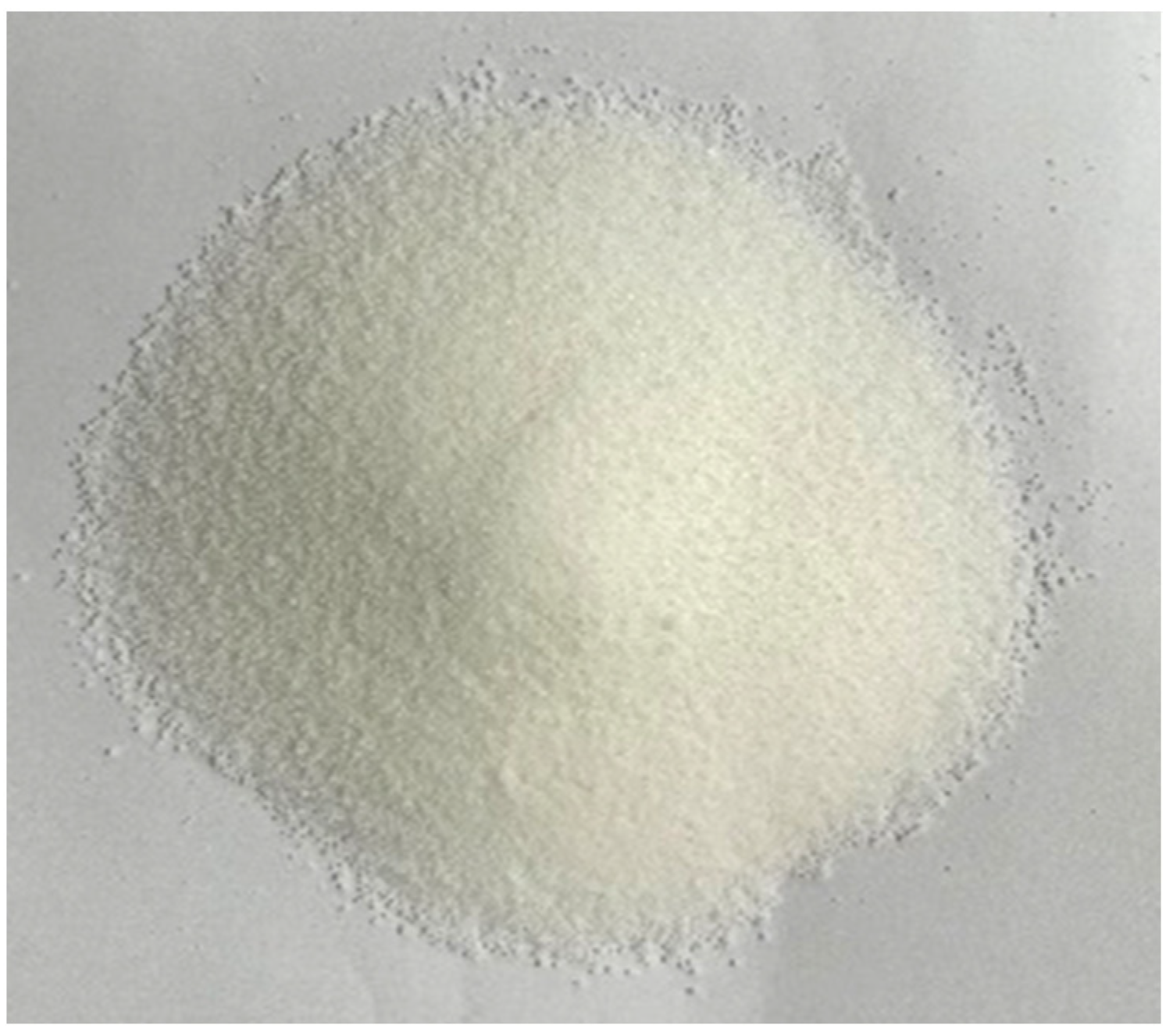
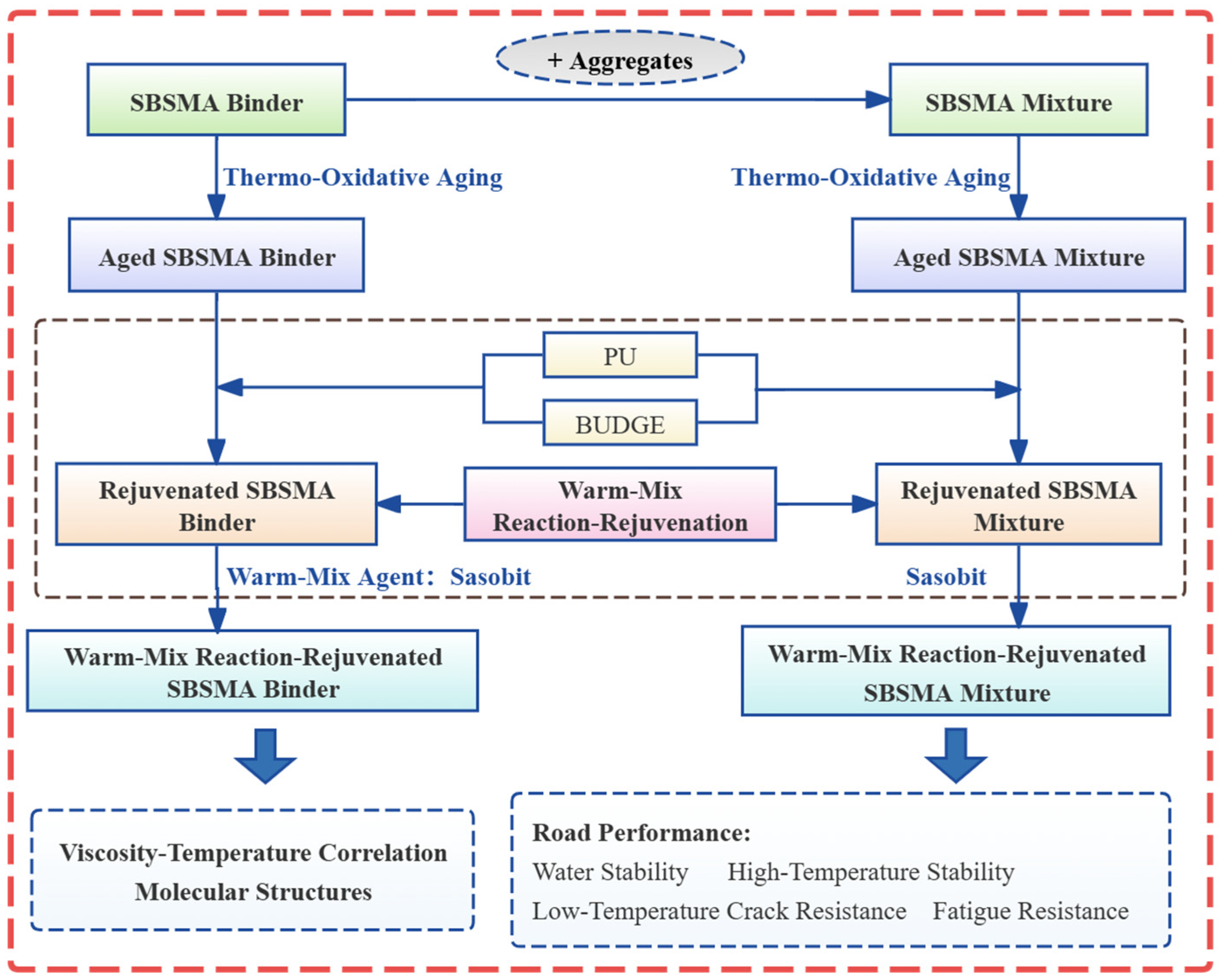

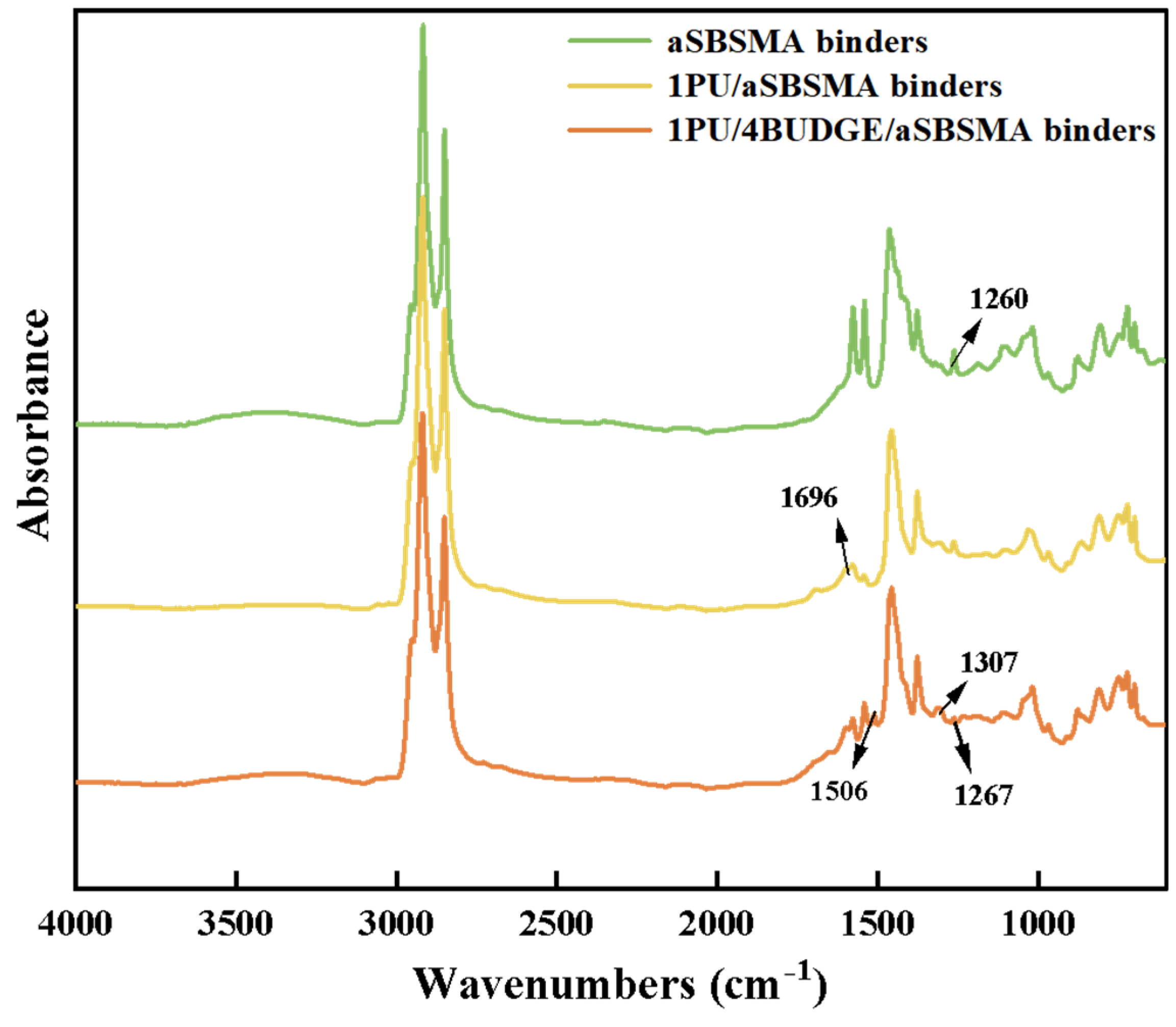


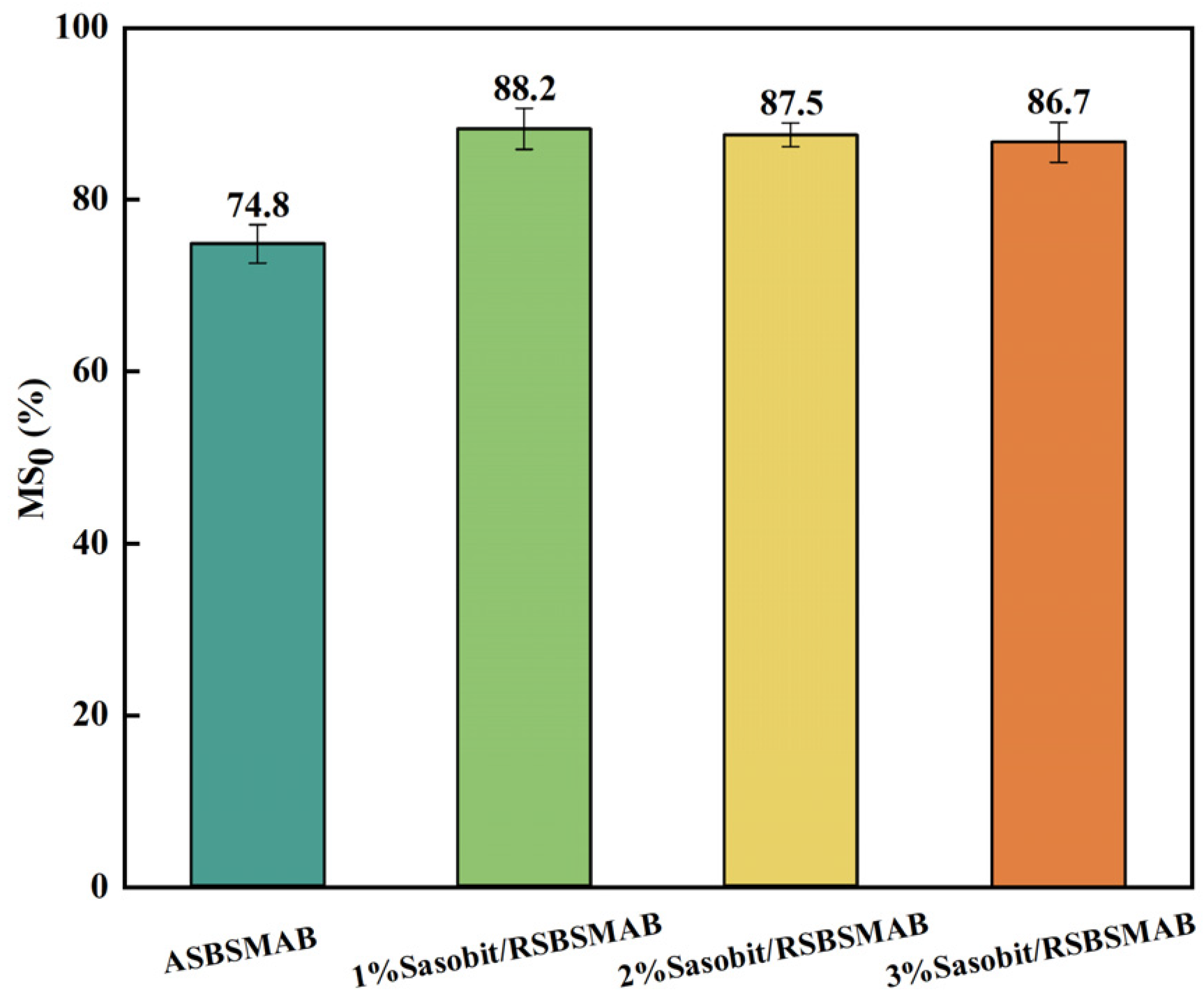
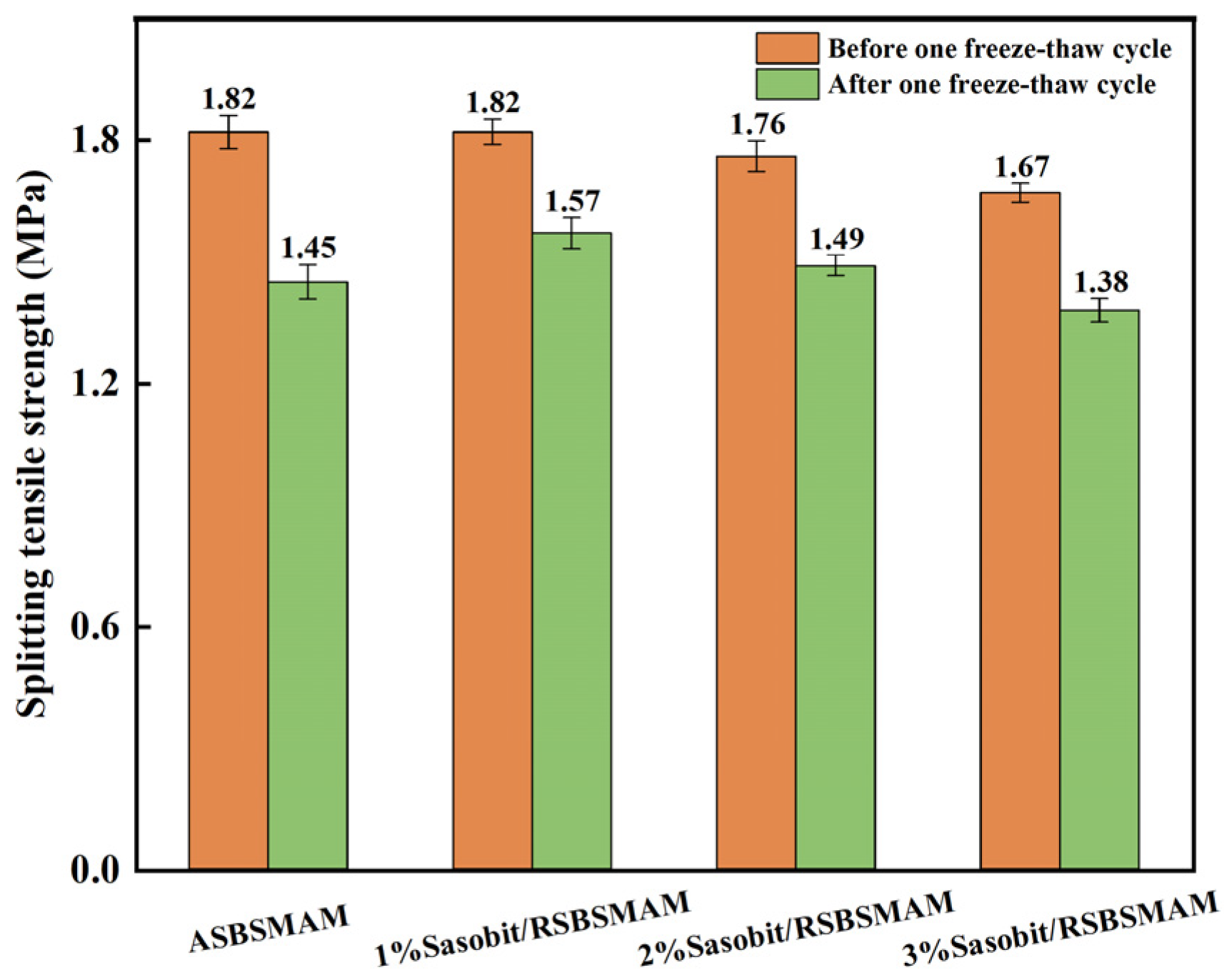
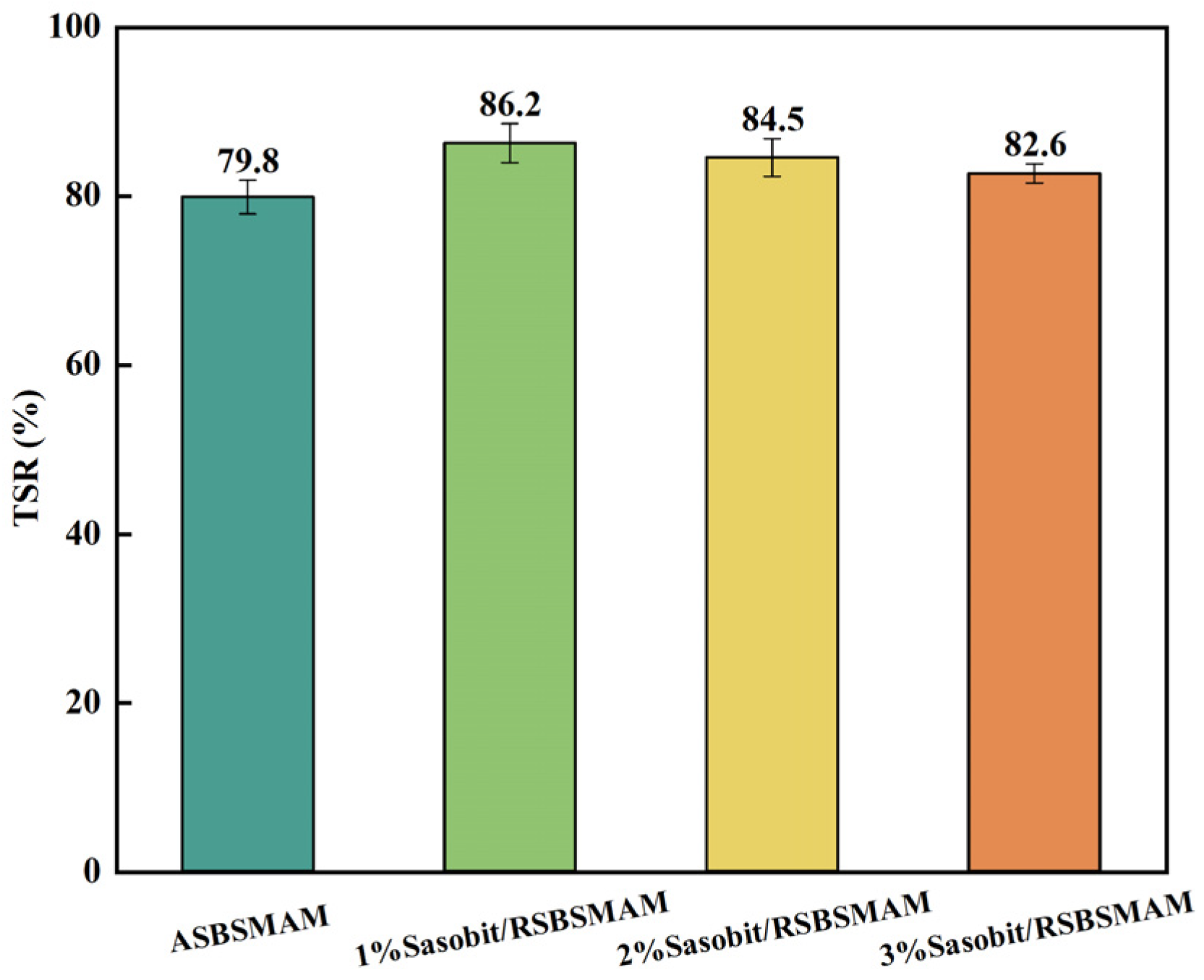
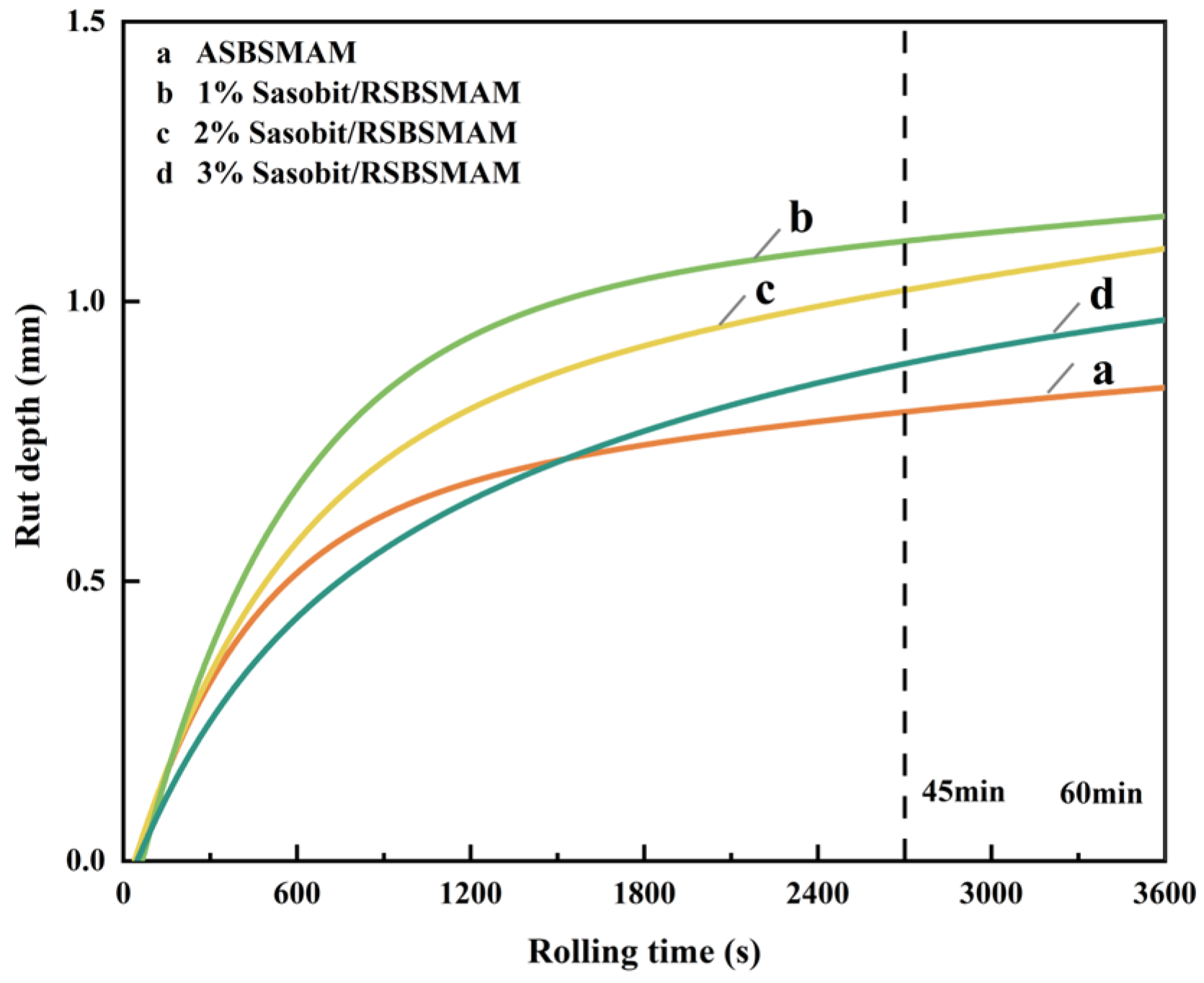
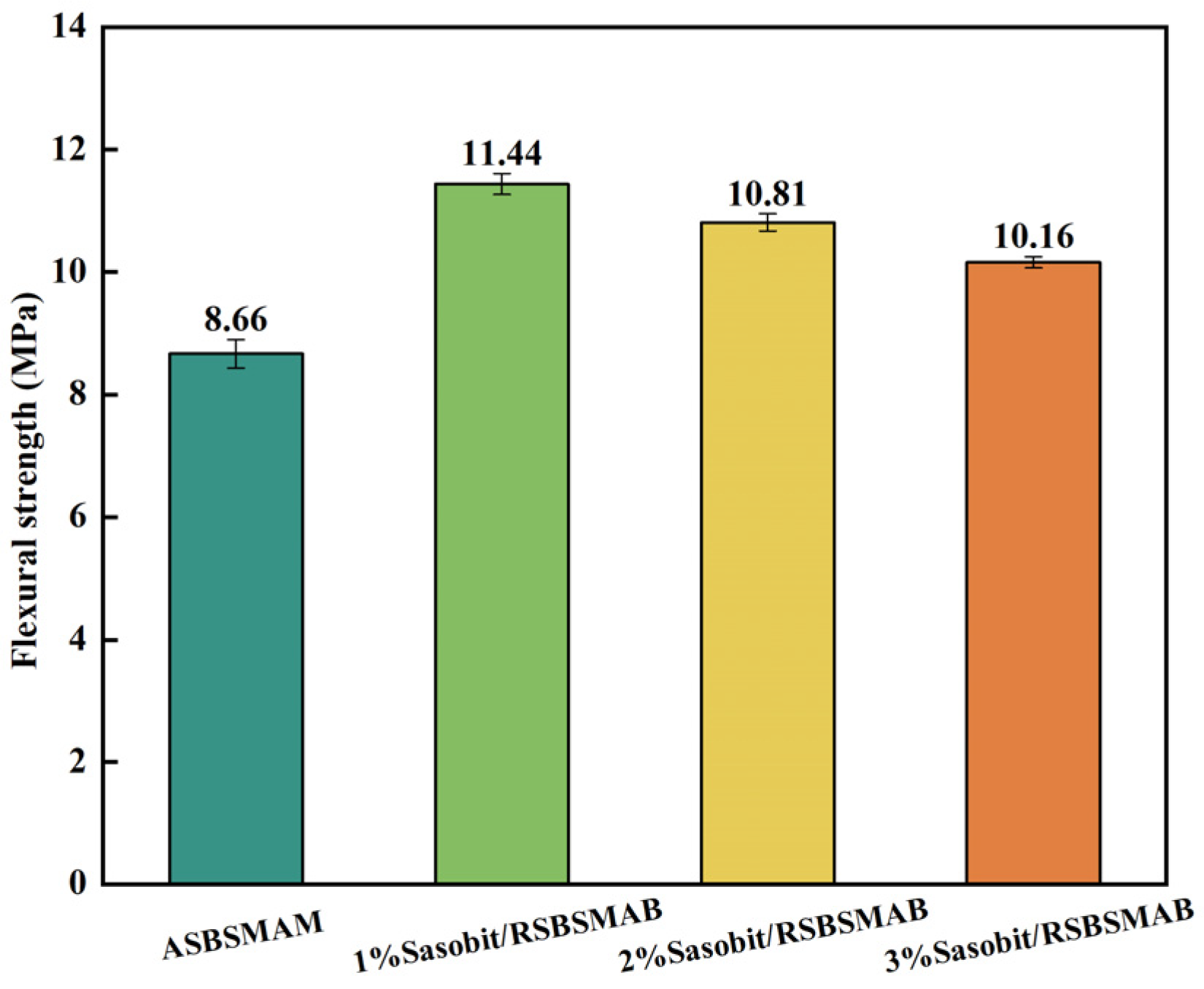
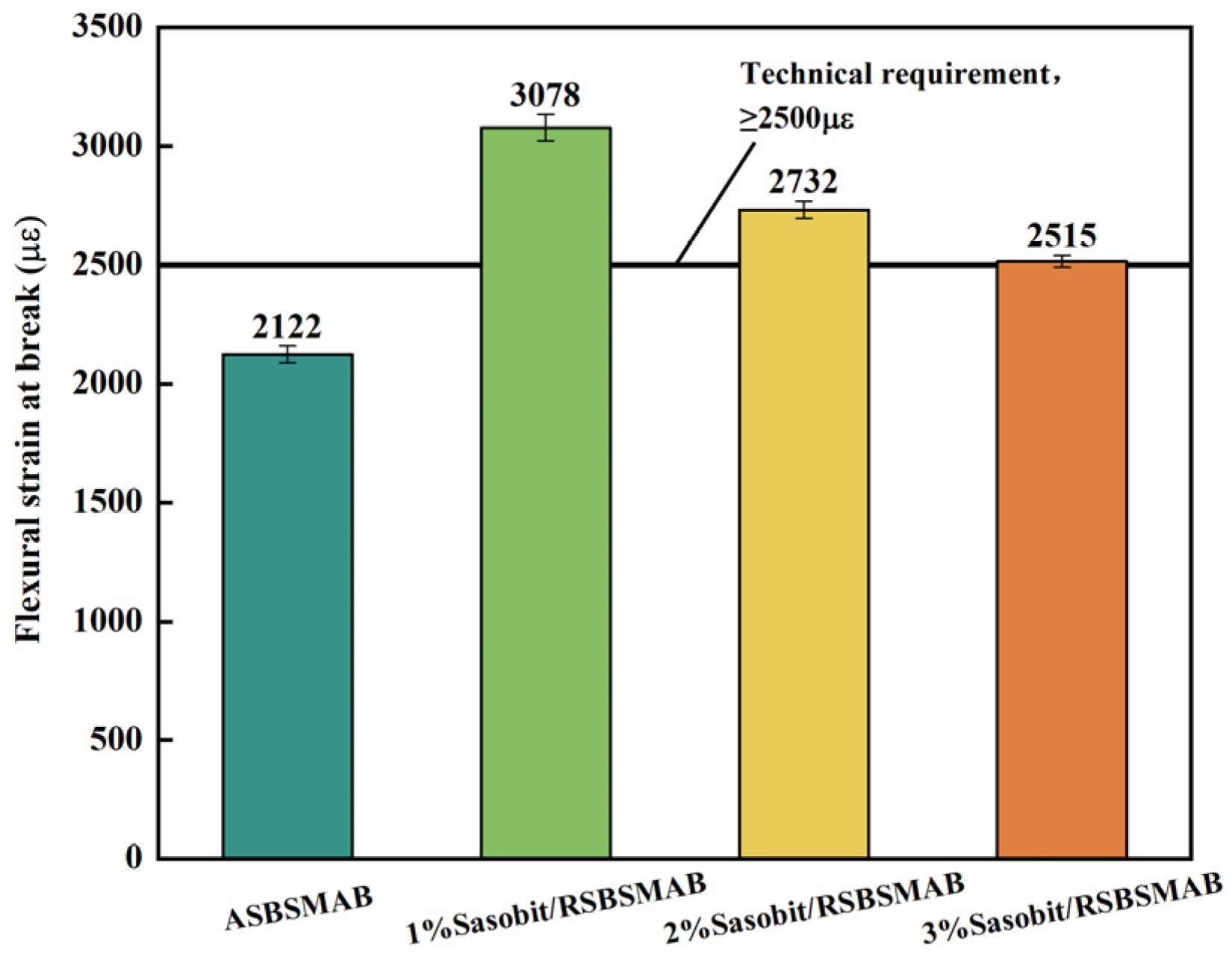
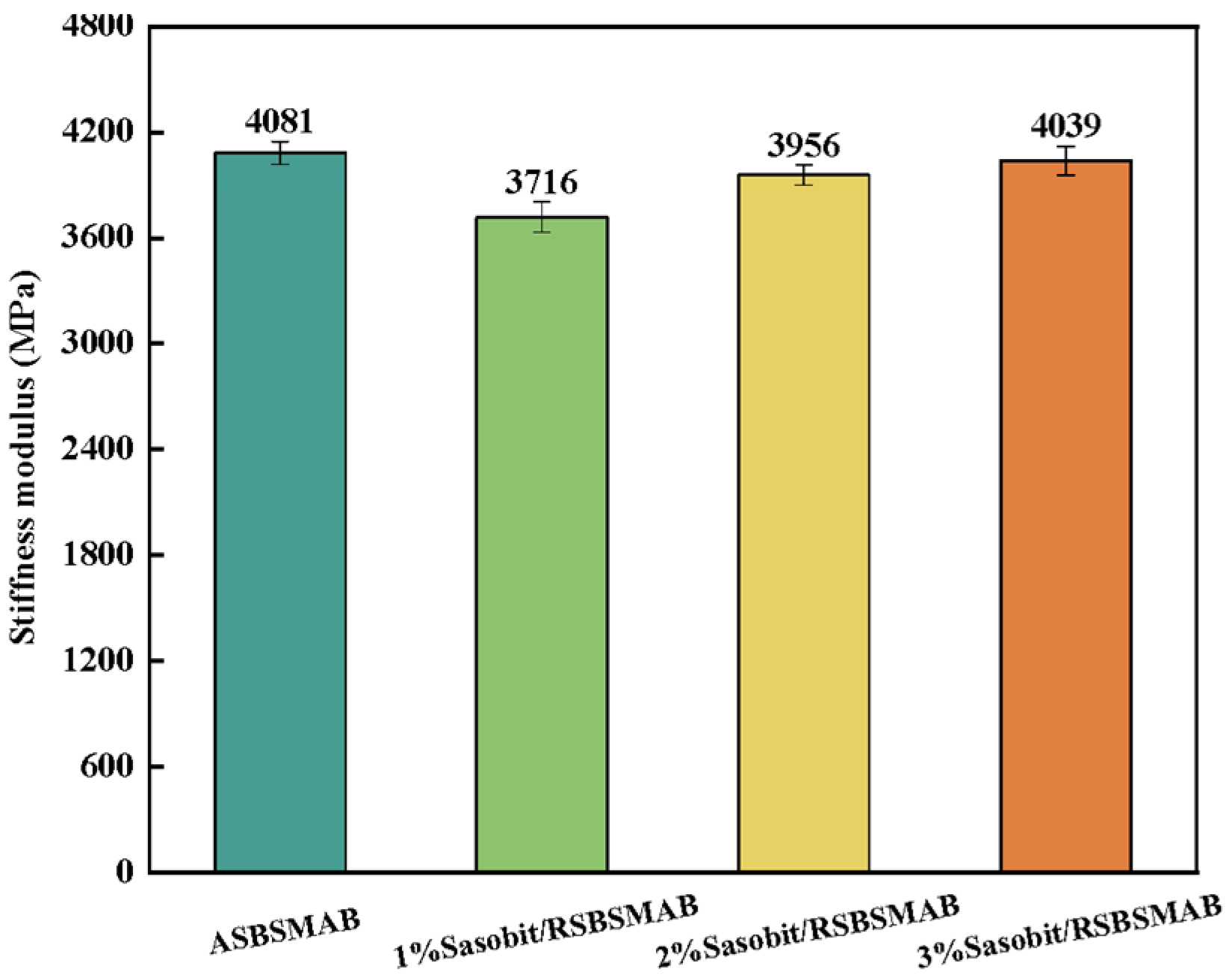
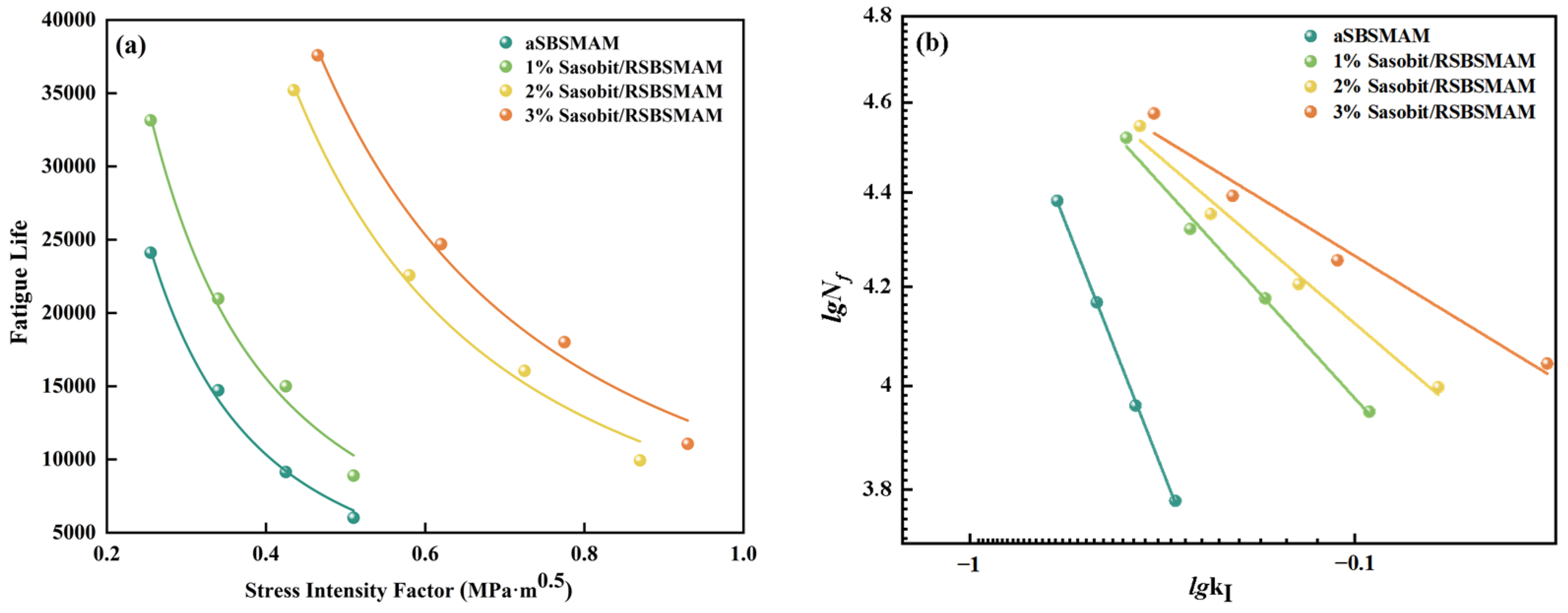
| Sieve Size, mm | 16 | 13.2 | 9.5 | 4.75 | 2.36 | 1.18 | 0.6 | 0.3 | 0.15 | 0.075 |
|---|---|---|---|---|---|---|---|---|---|---|
| Upper limit, % | 100 | 100 | 85 | 68 | 50 | 38 | 28 | 20 | 15 | 8 |
| Lower limit, % | 100 | 90 | 68 | 38 | 24 | 15 | 10 | 7 | 5 | 4 |
| Medium value, % | 100 | 95 | 76.5 | 53 | 37 | 26.5 | 19.0 | 13.5 | 10 | 6 |
| Job mix, % | 100 | 94 | 83 | 51 | 30 | 24 | 20 | 14 | 8.7 | 5.4 |
| Item | Viscosity–Temperature Equation | m | R2 |
|---|---|---|---|
| ASBSMA | 0.26 | 0.999 | |
| 1% Sasobit/RSBSMA | 0.25 | 0.973 | |
| 2% Sasobit/RSBSMA | 0.23 | 0.960 | |
| 3% Sasobit/RSBSMA | 0.20 | 0.935 |
| Item | t1, min | t2, min | ∆t, min | d1, mm | d2, mm | ∆d, mm | DS, Pass/mm |
|---|---|---|---|---|---|---|---|
| ASBSMAM | 45 | 60 | 15 | 0.891 | 0.980 | 0.089 | 7078 |
| 1% Sasobit/RSBSMAM | 1.182 | 1.296 | 0.114 | 5733 | |||
| 2% Sasobit/RSBSMAM | 1.061 | 1.173 | 0.112 | 6276 | |||
| 3% Sasobit/RSBSMAM | 0.953 | 1.048 | 0.095 | 6631 |
| Item | Exponential Equation | Linear Equation | n | lgK | R2 |
|---|---|---|---|---|---|
| ASBSMAM | −1.900 | 3.258 | 0.921 | ||
| 1% Sasobit/RSBSMAM | −1.641 | 3.856 | 0.948 | ||
| 2% Sasobit/RSBSMAM | −1.627 | 3.950 | 0.948 | ||
| 3% Sasobit/RSBSMAM | −1.584 | 4.052 | 0.957 |
Disclaimer/Publisher’s Note: The statements, opinions and data contained in all publications are solely those of the individual author(s) and contributor(s) and not of MDPI and/or the editor(s). MDPI and/or the editor(s) disclaim responsibility for any injury to people or property resulting from any ideas, methods, instructions or products referred to in the content. |
© 2024 by the authors. Licensee MDPI, Basel, Switzerland. This article is an open access article distributed under the terms and conditions of the Creative Commons Attribution (CC BY) license (https://creativecommons.org/licenses/by/4.0/).
Share and Cite
Liu, Z.; Chen, Q.; Pei, J.; Wang, R.; Shen, W.; Huang, C.; Liu, J.; Xu, X. Performance Evaluations of Warm-Mix Reaction-Rejuvenated SBS Modified Asphalt Mixtures Incorporated with Wax-Based Additive. Sustainability 2024, 16, 5234. https://doi.org/10.3390/su16125234
Liu Z, Chen Q, Pei J, Wang R, Shen W, Huang C, Liu J, Xu X. Performance Evaluations of Warm-Mix Reaction-Rejuvenated SBS Modified Asphalt Mixtures Incorporated with Wax-Based Additive. Sustainability. 2024; 16(12):5234. https://doi.org/10.3390/su16125234
Chicago/Turabian StyleLiu, Zihui, Qi Chen, Junwen Pei, Ruiyang Wang, Weili Shen, Chao Huang, Jialiang Liu, and Xiong Xu. 2024. "Performance Evaluations of Warm-Mix Reaction-Rejuvenated SBS Modified Asphalt Mixtures Incorporated with Wax-Based Additive" Sustainability 16, no. 12: 5234. https://doi.org/10.3390/su16125234






